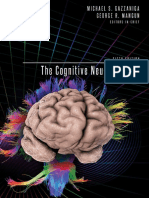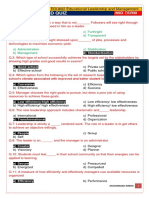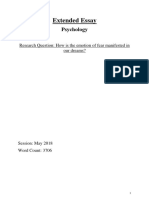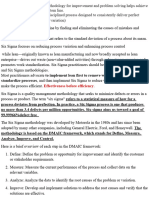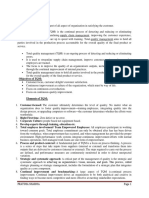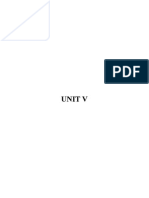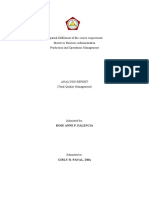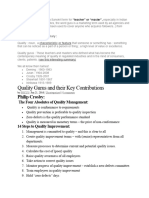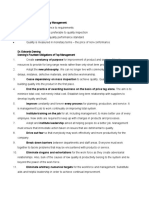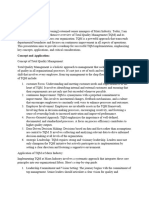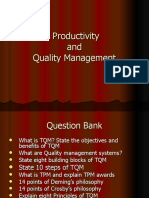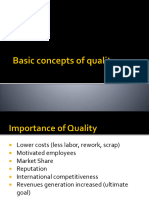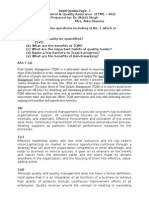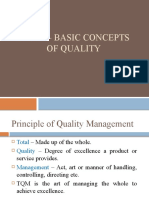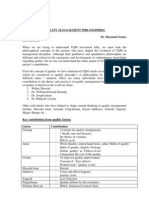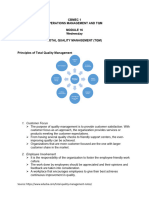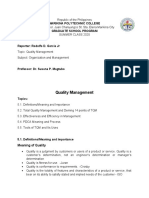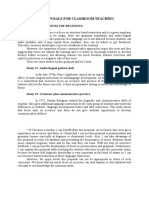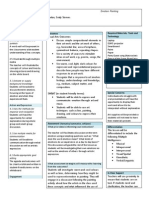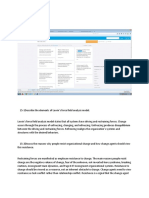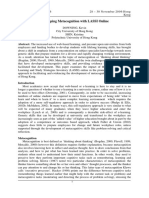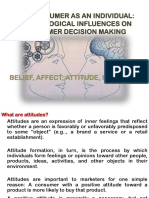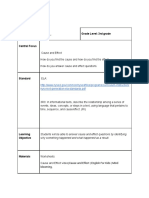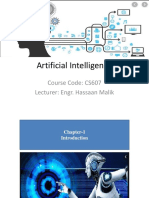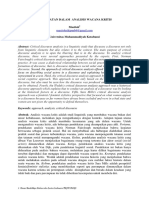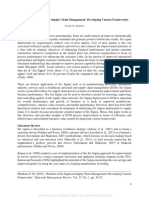0 ratings0% found this document useful (0 votes)
25 viewsTQM Operations Managements
TQM Operations Managements
Uploaded by
Rigine ButadThe document discusses the concepts of Total Quality Management (TQM) including Deming's 14 points for quality improvement and 7 key concepts for effective TQM implementation such as customer focus, continuous improvement, employee empowerment, benchmarking, and knowledge of quality tools. It also outlines 10 determinants of service quality including reliability, responsiveness, competence, access, and tangibles.
Copyright:
© All Rights Reserved
Available Formats
Download as PPTX, PDF, TXT or read online from Scribd
TQM Operations Managements
TQM Operations Managements
Uploaded by
Rigine Butad0 ratings0% found this document useful (0 votes)
25 views12 pagesThe document discusses the concepts of Total Quality Management (TQM) including Deming's 14 points for quality improvement and 7 key concepts for effective TQM implementation such as customer focus, continuous improvement, employee empowerment, benchmarking, and knowledge of quality tools. It also outlines 10 determinants of service quality including reliability, responsiveness, competence, access, and tangibles.
Original Description:
Total Quality Management
Original Title
TQM-Operations-Managements
Copyright
© © All Rights Reserved
Available Formats
PPTX, PDF, TXT or read online from Scribd
Share this document
Did you find this document useful?
Is this content inappropriate?
The document discusses the concepts of Total Quality Management (TQM) including Deming's 14 points for quality improvement and 7 key concepts for effective TQM implementation such as customer focus, continuous improvement, employee empowerment, benchmarking, and knowledge of quality tools. It also outlines 10 determinants of service quality including reliability, responsiveness, competence, access, and tangibles.
Copyright:
© All Rights Reserved
Available Formats
Download as PPTX, PDF, TXT or read online from Scribd
Download as pptx, pdf, or txt
0 ratings0% found this document useful (0 votes)
25 views12 pagesTQM Operations Managements
TQM Operations Managements
Uploaded by
Rigine ButadThe document discusses the concepts of Total Quality Management (TQM) including Deming's 14 points for quality improvement and 7 key concepts for effective TQM implementation such as customer focus, continuous improvement, employee empowerment, benchmarking, and knowledge of quality tools. It also outlines 10 determinants of service quality including reliability, responsiveness, competence, access, and tangibles.
Copyright:
© All Rights Reserved
Available Formats
Download as PPTX, PDF, TXT or read online from Scribd
Download as pptx, pdf, or txt
You are on page 1of 12
TOTAL QUALITY MANAGEMENT IN THE
TOURISM AND HOSPITALITY SERVICES
William Edwards Deming’s 14 Points for
implementing Quality Improvement:
1. Create consistency of purpose 7. Emphasize leadership
2. Lead to Promote Change 8. Drive out fear
3. Build Quality into the Product, depending 9. Break down barriers between departments
on inspections to catch problems.
10. Stop haranguing (Lecturing) Workers
4. Build long-term relationships based on
performance instead awarding business on 11. Support, help, and improve
the basis of price 12. Remove barriers to pride in work
5. Continuously improve product, quality, 13. Institute a vigorous program of education
service and self-improvement
6. Start Training 14. Put everybody in the company to work on
the transformation
SEVEN CONCEPTS FOR AN EFFECTIVE
TOTAL QUALITY MANAGEMENT (TQM)
• Total Quality Management (TQM) is a
management philosophy that emphasizes
continuous improvement in all aspects of an
organization's operations.
• TQM involves all employees in the organization,
from top management to front-line workers, in a
process of continual improvement.
• Here are seven concepts that can help ensure the
effective implementation of TQM:
SEVEN CONCEPTS FOR AN EFFECTIVE
TOTAL QUALITY MANAGEMENT (TQM)
1. Customer Focus: Customer satisfaction should be the ultimate goal of any
organization. All efforts should be directed towards meeting the needs and
expectations of customers.
2. Continuous Improvement/Six Sigma: Six Sigma is a set of techniques and tools for
process improvement. It was introduced by American engineer Bill Smith while
working at Motorola in 1986. The method counts the number of flaws in a process and
aims to systematically fix them.
• TQM is an ongoing process of improvement that never ends. All processes,
products, and services should be continually evaluated and improved upon to
increase efficiency and effectiveness.
SEVEN CONCEPTS FOR AN EFFECTIVE
TOTAL QUALITY MANAGEMENT (TQM)
3. Employee Empowerment: Employees at all levels should be empowered to make
decisions and take responsibility for their work. They should be encouraged to
contribute ideas and suggestions for improving processes.
a. Building communication networks that include employees.
b. Developing open, supportive supervisors
c. Moving responsibility from both managers and staff to production employees
d. Building high-moral organization
e. Creating such formal organizational structures as teams and quality circles.
SEVEN CONCEPTS FOR AN EFFECTIVE
TOTAL QUALITY MANAGEMENT (TQM)
4. Benchmarking: is a powerful tool for improving your performance in Total Quality
Management (TQM). It involves comparing your processes, products, and outcomes
with those of the best performers in your industry or sector.
a. Determine what to benchmark
b. Form a benchmark team
c. Identify benchmarking partners
d. Collect and analyze benchmarking information
e. Take action to match or exceed the benchmark
SEVEN CONCEPTS FOR AN EFFECTIVE
TOTAL QUALITY MANAGEMENT (TQM)
5. Just-In-Time(JIT): is an inventory management method in which goods are received
from suppliers only as they are needed. The main objective of this method is to reduce
inventory holding costs and increase inventory turnover.
a. JIT cuts cost of quality. Less Inventory on hand, costs are lower
b. JIT improves quality. It creates an early warning system for problems, both within the firm
and with vendors.
c. Better quality means less inventory and a better, easier-to-employ JIT system.
SEVEN CONCEPTS FOR AN EFFECTIVE
TOTAL QUALITY MANAGEMENT (TQM)
6. Taguchi Concepts: developed by Dr. Genichi Taguchi, is a statistical approach to
quality control that focuses on reducing variation and improving the quality of
products and processes. The method is based on three key concepts:
a. Quality Loss Function: The quality loss function is a mathematical model that quantifies
the cost of variation in product quality. It helps to determine the optimal level of quality
for a product or process by balancing the cost of improving quality with the cost of not
meeting customer requirements.
b. Parameter Design: Parameter design is a process of selecting the optimal combination of
input variables (factors) that will result in the desired output (response). The Taguchi
method uses a systematic approach to determine the optimal levels of these input variables
to minimize the effects of noise and other sources of variation.
c. Robust Design: Robust design is a design philosophy that aims to create products
and processes that are insensitive to sources of variation. The Taguchi method uses
statistical techniques to identify the factors that are most likely to cause variation
in the product or process and to develop designs that are robust to these sources of
variation.
SEVEN CONCEPTS FOR AN EFFECTIVE
TOTAL QUALITY MANAGEMENT (TQM)
7. Knowledge of TQM Tools:
a. Check Sheets - Forms designed for recording data
b. Scatter diagrams – Shows the relationship between two measurements
c. Cause and Effect Diagrams – AKA Ishikawa Diagram or Fish-Bone chart. It is
a schematic technique used to discover possible locations of quality problems.
d. Pareto Chart - Pareto analysis is a technique used to identify the most common
causes of problems. It is based on the principle that 80% of problems are
caused by 20% of the causes.
e. Flow Chart - are diagrams that show the sequence of steps in a process. They help
to identify areas of inefficiency or problems in a process and can be used to
develop improvements.
f. Statistical Process Control (SPC) - SPC is a set of statistical techniques used to monitor
and control a process to ensure that it operates within specified limits. It helps to identify
when a process is producing defective products and allows for corrective action to be
taken.
g. Histograms or Stem-and-Leaf Plot – These show the range of values of a
measurement and the frequency with which each value occurs. They show the
most frequently occurs readings as well as the variations in the measurements.
DETERMINANTS OF SERVICE
QUALITY
1. Reliability – This involves consistency of performance and dependability. It
means that the firm performs the service right the first time and that the firm
honors its promises.
2. Responsiveness – It concerns the willingness of readiness of employees to
provide service. It involves timeliness of service.
3. Competence – means possession of the required skills and knowledge to
perform the service.
4. Access – Involves approachability and ease of contact
5. Courtesy – Involves politeness, respect, consideration, and friendliness of
contact personnel (Including receptionists, telephone operators, etc.).
DETERMINANTS OF SERVICE
QUALITY
6. Communication – means keeping customers informed in a language that they
understand. It means that the company has to adjust its language to its different
consumers
7. Credibility – Involves trustworthiness, believability, and honestly. It involves
having the customer’s best interest at heart.
8. Security – Is the freedom from danger, risk, or doubt.
9. Understanding/Knowing – the customer involves making the effort to
understand the customer’s needs and wants.
10. Tangibles – include the physical evidence of the service.
You might also like
- Gazzaniga and Mangun 2014. The Cognitive NeurosciencesDocument1,187 pagesGazzaniga and Mangun 2014. The Cognitive NeurosciencesFelipe Quezada93% (30)
- EDU602 Educational Leadership and Management (MCQs GRAND QUIZ MID TERM) PASTDocument8 pagesEDU602 Educational Leadership and Management (MCQs GRAND QUIZ MID TERM) PASTMuhammad Ahmad100% (9)
- Maria Montessori CurriculumDocument38 pagesMaria Montessori Curriculumlaren67% (3)
- ESP Course and Syllabus Design Paper PDFDocument23 pagesESP Course and Syllabus Design Paper PDFputri novaNo ratings yet
- Making Sense of WordsDocument10 pagesMaking Sense of WordsgnobeNo ratings yet
- Psychology Extended EssayDocument21 pagesPsychology Extended EssaySimran Vani100% (1)
- Chapter 6. Managing QualityDocument6 pagesChapter 6. Managing QualityNico Gabrielle GarciaNo ratings yet
- Operation Management - Chapter 1&2 Assignment - GamuedaDocument4 pagesOperation Management - Chapter 1&2 Assignment - GamuedaJovani GamuedaNo ratings yet
- Novemberdecember 2011Document14 pagesNovemberdecember 2011Priyadharshni SelvarajNo ratings yet
- Total Quality Management: by S. LucasDocument77 pagesTotal Quality Management: by S. Lucasjohn enockNo ratings yet
- Kmbn205 Unit 5Document26 pagesKmbn205 Unit 5akshitbhardwaj790No ratings yet
- Total Quality Management-GHCFGFDocument10 pagesTotal Quality Management-GHCFGFNehaNo ratings yet
- Quality Gurus and Their Key ContributionsDocument4 pagesQuality Gurus and Their Key Contributionsirish ohNo ratings yet
- OpMan-Chapter 6 - QualityDocument57 pagesOpMan-Chapter 6 - QualityTrina Mae RodriguezNo ratings yet
- Quality: Q P / E P Performance E ExpectationsDocument39 pagesQuality: Q P / E P Performance E ExpectationsBHUSHAN PATILNo ratings yet
- Kmbn205 Unit 5Document27 pagesKmbn205 Unit 5akshitbhardwaj790No ratings yet
- Francia Quality and Business Process Reengineering DiscussionDocument12 pagesFrancia Quality and Business Process Reengineering DiscussionEd FeranilNo ratings yet
- Six Sigma &lean Six SigmaDocument6 pagesSix Sigma &lean Six SigmaThe Red EagleNo ratings yet
- Unit V OmDocument18 pagesUnit V Omshivangi goyalNo ratings yet
- Lesson 10Document28 pagesLesson 10Tirusameer YarlagaddaNo ratings yet
- Total Quality Management in Healthcare-Chapter OneDocument5 pagesTotal Quality Management in Healthcare-Chapter OneDavid KimosopNo ratings yet
- Quality MGTDocument10 pagesQuality MGTLablay LaerNo ratings yet
- Unit 1-Quality Management-MergedDocument114 pagesUnit 1-Quality Management-MergedakhilNo ratings yet
- Total Quality Management (TQM)Document31 pagesTotal Quality Management (TQM)malathi100% (1)
- TQM & HRMDocument6 pagesTQM & HRMmansiNo ratings yet
- Total Quality ManagementDocument7 pagesTotal Quality ManagementRose Anne PalenciaNo ratings yet
- Sree Sowdambika College of Engineering Chettikurichi, Aruppukottai Department of Electronics and Communication Engineering Internal Test - IDocument10 pagesSree Sowdambika College of Engineering Chettikurichi, Aruppukottai Department of Electronics and Communication Engineering Internal Test - Ikavitha saravananNo ratings yet
- Total Quality Management: By: Zaipul Anwar Manager, R & D Dept. Business & Advanced Technology Centre UTMDocument14 pagesTotal Quality Management: By: Zaipul Anwar Manager, R & D Dept. Business & Advanced Technology Centre UTMविशाल छुगानीNo ratings yet
- Quality Gurus 2013Document5 pagesQuality Gurus 2013weldeabrha kirosNo ratings yet
- Gurus of Total Quality Management: ObjectivesDocument15 pagesGurus of Total Quality Management: ObjectivesKaryll JustoNo ratings yet
- 6organizational Innovations:total Quality Management Just-In-Time Production SystemDocument10 pages6organizational Innovations:total Quality Management Just-In-Time Production SystemAryan LeeNo ratings yet
- Philip CrosbyDocument3 pagesPhilip Crosbyarpit guptaNo ratings yet
- Deming 14 Principles of Quality ManagementDocument5 pagesDeming 14 Principles of Quality ManagementSomadutta TripathyNo ratings yet
- Total Quality Management: Assignment 01Document9 pagesTotal Quality Management: Assignment 01Lasitha NawarathnaNo ratings yet
- Total Quality Management PG QP DEC 2023.revised 4yehtPbBCJDocument5 pagesTotal Quality Management PG QP DEC 2023.revised 4yehtPbBCJroman reignsNo ratings yet
- Intro To TQMDocument4 pagesIntro To TQMAlyssa PuentespinaNo ratings yet
- Module 3-TQMDocument17 pagesModule 3-TQMRevenlie GalapinNo ratings yet
- Productivity and Quality MGMT v2Document87 pagesProductivity and Quality MGMT v2Minal ShahNo ratings yet
- Basic Concepts of QualityDocument20 pagesBasic Concepts of QualityDhanushkaNo ratings yet
- المحاضرة الثانيةDocument20 pagesالمحاضرة الثانيةa.abdeewi99No ratings yet
- Total Quality Management: A Continuous Improvement ProcessDocument26 pagesTotal Quality Management: A Continuous Improvement ProcessMAKKAR_ROHITNo ratings yet
- Model Question Paper QCQADocument10 pagesModel Question Paper QCQASubrata DasNo ratings yet
- Total Quality Management Dec-2023Document9 pagesTotal Quality Management Dec-2023kumar.rajan0108No ratings yet
- Unit 1 - Total Quality ManagementDocument58 pagesUnit 1 - Total Quality Managementavdesh palNo ratings yet
- Chap - 2 Quality Management Philosophy PDFDocument11 pagesChap - 2 Quality Management Philosophy PDFSnehlata Saraf100% (2)
- Lecture Guide Unit 2 - AE18 - Quality Guru & Kaizen Concept 2022-2023Document34 pagesLecture Guide Unit 2 - AE18 - Quality Guru & Kaizen Concept 2022-2023Yeye GatdulaNo ratings yet
- Iom Quality NotesDocument8 pagesIom Quality Notesowuor PeterNo ratings yet
- PPT3-Managing QualityDocument29 pagesPPT3-Managing QualityIka FitriNo ratings yet
- Chapter Three: Total Quality Management and Iso-9000Document33 pagesChapter Three: Total Quality Management and Iso-9000tolossa assefaNo ratings yet
- Cbmec1 M15 WedDocument5 pagesCbmec1 M15 Wedilalimngputingilaw3No ratings yet
- Total Quality Management (TQM)Document35 pagesTotal Quality Management (TQM)cyndrellaNo ratings yet
- Heizer Chapter 6 - Managing QualityDocument17 pagesHeizer Chapter 6 - Managing QualityANo ratings yet
- Methods of It Project Management 2nd Edition Brewer Test BankDocument17 pagesMethods of It Project Management 2nd Edition Brewer Test BankwolfgangmagnusyyaNo ratings yet
- Project Quality ManagementDocument39 pagesProject Quality ManagementElloani Ross Arcenal Pitogo100% (2)
- TQM Notes Unit-1Document14 pagesTQM Notes Unit-1GAURAV GUPTANo ratings yet
- Assignment SEQDocument13 pagesAssignment SEQVicky KdNo ratings yet
- Total Quality ManagementDocument9 pagesTotal Quality Managementsankalpsharma586No ratings yet
- Revisi PPT3-Managing QualityDocument28 pagesRevisi PPT3-Managing QualityAbdul GhoniNo ratings yet
- Total Quality Management AssignmentDocument8 pagesTotal Quality Management AssignmentAnubha GuptaNo ratings yet
- TQM Reviewer PDFDocument15 pagesTQM Reviewer PDFJasmine LimNo ratings yet
- ReviewerDocument5 pagesReviewerayaa caranzaNo ratings yet
- Total Quality ManagementDocument4 pagesTotal Quality ManagementKrisha Pioco TabanaoNo ratings yet
- Report Written Quality ManagementDocument7 pagesReport Written Quality ManagementRod Dumala GarciaNo ratings yet
- Six Proposals For Classroom Teaching: 1. Get It Right From The BeginningDocument8 pagesSix Proposals For Classroom Teaching: 1. Get It Right From The BeginningFebriRotamaSilabanNo ratings yet
- Music LessonDocument3 pagesMusic Lessonapi-280508393No ratings yet
- MMPC-11 2023Document8 pagesMMPC-11 2023hewmour androidNo ratings yet
- Learning and Motivation NoteDocument23 pagesLearning and Motivation NoteAjayi Esther100% (1)
- Chapter 15 SummaryDocument11 pagesChapter 15 SummaryGil Hernandez-ArranzNo ratings yet
- The Future of CommunicationDocument16 pagesThe Future of CommunicationShahad Ahmad AlNasserNo ratings yet
- Ulbs Scoring CriteriaDocument2 pagesUlbs Scoring CriteriacharanjitNo ratings yet
- Developing Metacognition With LASSI OnlineDocument12 pagesDeveloping Metacognition With LASSI OnlineEduardo GuadalupeNo ratings yet
- Presentation On Consumer AttitudeDocument13 pagesPresentation On Consumer AttitudeMD JAFAR SHARIFNo ratings yet
- 2 Лекция. Functional Linguistics.Document47 pages2 Лекция. Functional Linguistics.ZzzKkkNo ratings yet
- Cbse 4221 Lesson Plan Pop Cycle 1Document12 pagesCbse 4221 Lesson Plan Pop Cycle 1api-601069857No ratings yet
- Gillette's Total Quality Management System Case StudyDocument9 pagesGillette's Total Quality Management System Case StudyWasif AliNo ratings yet
- Lesson Plan: "The Family Is One of Nature's Masterpieces" George SantayanaDocument4 pagesLesson Plan: "The Family Is One of Nature's Masterpieces" George Santayanaureche gabrielaNo ratings yet
- Psychological Foundations: of CurriculumDocument47 pagesPsychological Foundations: of CurriculumJer LeneNo ratings yet
- Introducing Social PsychologyDocument10 pagesIntroducing Social Psychologydevyani rathodNo ratings yet
- What Semiotics Can and Cannot Do For HCI: Peter Bùgh AndersenDocument6 pagesWhat Semiotics Can and Cannot Do For HCI: Peter Bùgh AndersenOctavina PutriNo ratings yet
- Giving Feedback Minipaper ONLINEDocument28 pagesGiving Feedback Minipaper ONLINEFabio100% (1)
- Definition of ESPDocument2 pagesDefinition of ESPAlya Kayca0% (1)
- Artificial Intelligence: Course Code: CS607 Lecturer: Engr. Hassaan MalikDocument41 pagesArtificial Intelligence: Course Code: CS607 Lecturer: Engr. Hassaan MalikHassaan Malik100% (5)
- Oral Communication in Context: Quarter 1 - Module 3: Strategies To Avoid Communication BreakdownDocument27 pagesOral Communication in Context: Quarter 1 - Module 3: Strategies To Avoid Communication BreakdownRuben67% (3)
- Pendekatan Dalam Analisis Wacana Kritis: AbstractDocument11 pagesPendekatan Dalam Analisis Wacana Kritis: AbstractM Danial FahmiNo ratings yet
- Benefits of Six Sigma in Supply Chain MaDocument8 pagesBenefits of Six Sigma in Supply Chain MaAjayi AugustineNo ratings yet
- Notes Unit 1Document9 pagesNotes Unit 1Muskan KaurNo ratings yet
- DLL 7es TemplateDocument2 pagesDLL 7es Templateasia bagayNo ratings yet
